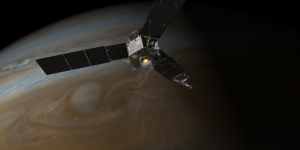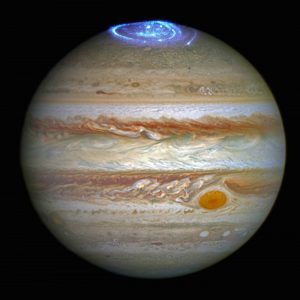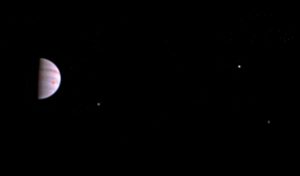Juno’s first shot of Jupiter is finally here and it’s a striking half-lit view of the red planet and moons. The planet’s iconic giant red spot is in clear view and it’s joined by three of its four Galilean moons, Io, Europa and Ganymede.
The picture was taken on July 10th at a distance of 4.3 million kilometers from the planet courtesy of the onboard JunoCam.
The image was a long time coming for NASA as they had launched the probe from Earth five years ago in August 2011. But it was a welcome sight at Mission Control, where workers were seen hugging, clapping, and cheering at the announcement of the spacecraft’s safe arrival.
“This scene from JunoCam indicates it survived its first pass through Jupiter’s extreme radiation environment without any degradation and is ready to take on Jupiter,” said Scott Bolton, principal investigator for Juno. “We can’t wait to see the first view of Jupiter’s poles.”
The almost five-year journey wasn’t an easy one. Along the way, the basketball-sized probe had to dodge space debris and hold up to radiation. Jupiter has a ring of rocks and dust similar to Saturn’s that it needed to avoid.

First on Juno’s roadmap is a 53-day orbit around the gas giant. Onboard instruments will measure the planet’s weather patterns, investigate whether it may have a solid core, and gather clues about how the planet was formed and its history in the solar system.
Meanwhile, pictures out of JunoCam will be used to sustain public engagement in the project. Watch out for JunoCam’s first high-resolution images of Jupiter on August 27th when the probe will get as close as 4,100 kilometers to the planet and give us the best views ever seen of its cloudy atmosphere.
One of the most anticipated images to come includes a close up shot of the planet’s auroras at its poles. The northern and southern lights are the largest of any planet in our solar system due to the size of Jupiter’s magnetosphere.

Overall, Juno’s mission will last 20 months and it will circle the planet 37 times before concluding its mission. Because scientists believe Europa could house life under its ice crust, they didn’t want to risk the probe accidentally running into it and contaminating the environment. So they plan to plunge the spacecraft into Jupiter’s atmosphere in a fiery death. This might sound brutal but we can take solace in knowing it will nobly continue sending information about the atmosphere up until the very end.











